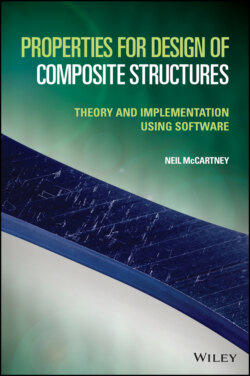Читать книгу Properties for Design of Composite Structures - Neil McCartney - Страница 9
Preface
ОглавлениеThe effective properties of composite materials, such as thermoelastic and conductive, depend upon the nature of many materials’ characteristics, which are needed to account for the composite structure, e.g. particulate or fibre reinforcement, unidirectional plies or multi-layered laminates. Account also must be taken of the resultant anisotropies that are often required when designing three-dimensional engineering components. Indeed, the properties of some constituents can be anisotropic themselves, such as carbon fibres and the individual plies of laminates. The accurate experimental determination of these properties is rarely, if ever, achieved in practice, and this leads on to the need for reliable estimation methods using analytical and/or numerical methods.
It is emphasised here that this book is not intended to be a reference text. The principal objective is to provide readers with a single source for a wealth of analytical methods and explicit formulae that can be used to estimate the effective properties of a wide range of composite types for both undamaged and damaged states. Readers wishing to track in more detail the historical development of composite theory will need to consult the literature, possibly starting with the limited number of references included in this book.
This book has been written over a number of years following the encouragement of the late Professor Anthony Kelly, FRS, CBE, to whom the author owes an enormous debt of gratitude. Professor Kelly was the Chairman of the Panel at the National Physical Laboratory (NPL) that decided, in 1969, that the author, following six months’ probation, could be offered a permanent post. The author now has an Emeritus position at NPL (Senior NPL Fellow) that has enabled continued research on various aspects of material science, and the writing of this book. A much closer relationship developed when, in the early 1980s, we both independently solved a problem considered in Chapter 14. At that point and onwards Professor Kelly, who was then Vice-Chancellor of Surrey University, introduced the author to many theoretical aspects of composite technology, which are included in this book. Of particular note is the development of methods of analysing the effects of fibre fractures and matrix cracks in unidirectionally reinforced composites, extending the pioneering work of colleagues at NPL, which led to the very well-known ACK (Aveston, Cooper, Kelly) theory, developed in 1971, which continues to be widely cited in the literature.
Following the Introduction, Chapter 2 of this book introduces and describes in detail many continuum analyses that will be required in later chapters. Chapters 3–7 are concerned with a description of methods of estimating the effective properties of undamaged composite materials, including those reinforced with aligned spheroidal particles. Extensive use is made of the methodology developed by James Clerk Maxwell in his book on electromagnetism, where an ingenious analytical method is used to estimate the effective electrical conductivity of a uniformly distributed assembly of isotropic spherical particles. His result is thought to be the first expression ever developed for an effective property of a composite. His methodology is also extremely powerful and worthy of extensive use in this book.
During service, composite components are often exposed to loadings that are sufficient to cause the formation of microstructural damage such as fibre failures or matrix cracking, which are usually associated with the occurrence of fibre/matrix interface debonding. For laminates, delamination at ply interfaces is an additional form of load-induced damage. The initiation and growth of microstructural damage affects the effective properties of composite materials, which degrade. It is remarkable that the degradation of very many thermoelastic constants is characterised by a single damage dependent function, as will become clear in the book. Sometimes damage mechanisms lead to local stress-transfer within complex structures, which can delay the onset of structural failure during progressive loading. Chapters 8–14 of this book will focus on analytical and semi-analytical methods of predicting both the effect of damage on effective properties and, more importantly, the dependence of effective properties on local loading conditions when using an energy balance approach. Chapters 13 and 14 concern, respectively, a model of damage development during the fatigue loading of laminates and a model of composite degradation due to environmental damage (in fibres).
Chapters 15–19 comprise more advanced analyses, providing mathematical details of many complex derivations that arise when considering: i) the effective properties of aligned systems of spheroids, ii) interface debonding associated with a fibre fracture or matrix crack in a unidirectional composite, iii) the behaviour of bridged cracks of finite length in a unidirectional composite, iv) the behaviour of ply cracks of finite length in a cross-ply laminate, v) stress-transfer mechanics for general symmetric laminates subject to general in-plane loading and vi) stress-transfer mechanics associated with out-of-plane orthogonal bending of cross-ply laminates that do not need to be symmetric. The models considered can lead to analytical formulations that require the use of numerical methods to deal with the complexity arising from the use of analytical techniques. Software implementing the analysis described in this book is provided at the Wiley website link (www.wiley.com/go/mccartney/properties).
The author would like to take this opportunity to thank all colleagues at NPL, and in other institutions around the world, for all the technical interactions that have helped greatly to formulate and investigate the various aspects of composite materials that are described in this book. My thanks also extend to the staff at John Wiley, who have been very patient while the book has been completed, and for their considerable help in the final stages of book preparation.
This book is dedicated to my late wife, Irene, and all our family, who have encouraged the completion of this book despite the many years in preparation. The author cannot thank them enough for allowing him the time in their lives, first to undertake the research that is described, and then the writing of the book itself.
L N McCartney
April 2022
